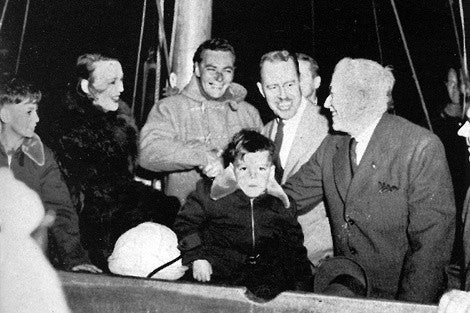While some students may have traveled as far, none has likely taken as long to reach Harvard School of Public Health as Thomas Davis, MPH ’54, who spent five months sailing from New Zealand aboard a 45-foot ketch.
A surgeon from the Cook Islands, Davis made the 10,000-mile voyage with his wife, two sons (ages five and 10), and two crewmen. He decided to use his trip to the U.S. to test a theory made famous by Thor Heyerdahl’s 1947 Kon-Tiki expedition, which sought to prove that people from South America could have settled in Polynesia in pre-Colombian times. By contrast, the part-Polynesian Davis, a specialist in tropical medicine with a passionate interest in Polynesian anthropology, set out to prove that that Polynesians could have made a round-trip passage.
The travelers’ route took them to Peru, through the Panama Canal, and along the eastern seaboard to Boston, according to a November 3, 1952 report in the Harvard Crimson. Through the months, they faced down winter storms with 40 foot waves and 75 mile per hour winds. Anchors were lost. A compass washed overboard. Food and water ran low. “Dr. Davis himself lost 25 lbs. But the two small boys, not on rations, had gained weight as small boys should,” Time magazine reported in a September 15, 1952 piece on the voyage.
Davis’s ketch, the Miru—named after the legendary mother of the Polynesian race—docked in the Charles River Basin on November 2, 1952, two months late. “He should have been fined $10 for late registration, but wasn’t,” the Crimson reported. “Instead the tardy student was greeted dockside by the dean of the Public Health School, Brig. Gen. James Stevens Simmons, and later was elected president of his class following a bibulous beer party for him in the School’s staid lobby.”
After graduation, Davis returned to the Cook Islands, going on to serve as prime minister from 1978 to 1987. In 1981, he was knighted by Queen Elizabeth. Among his professional accomplishments, the multi-talented physician served as chief medical officer for the Cook Islands, reorganizing the Cooks’ health service “to offer better health care in the widely scattered island.” He also published more than 60 scientific papers and two books, one of them the memoir Island Boy, before his death at the age of 90, according to a 2007 obituary in the New Zealand Herald.
* * * * *
Is there an event, person, or discovery in Harvard School of Public Health history that you’d like to read about? Send your suggestions to centennial@hsph.harvard.edu.
